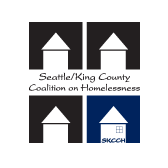Below is the lead story of our Winter 2015 Groundviews newsletter. To read the entire newsletter online, please visit our Groundviews webpage.
Today, Alena Rogers lives happily in permanent housing with her two boys, now 18 and nearly 5 years old, and she recently started a full-time graduate program in Couples & Family Therapy at Seattle’s Antioch University. But just five years ago, she was in a very different place. In her own words, Alena shares her powerful story and her experiences working with JourneyHome Case Manager Victoria Meissner and Housing Advocate Becky Armbruster to get back to housing stability.

Alena Rogers, JourneyHome program participant, with her two boys, Brian (left) & Gabriel (center), in 2010
“In 2009 I entered a court-ordered treatment program after getting into trouble. While there, I came to understand that I could not go back and live with any of the people that I had been living with, or I would not stay sober. So I heard about a shelter in Seattle and was able to get in there. After completing their 14-month program, I went into their transitional housing program. However, they seemed unable to help me with my quest for permanent housing, so I searched for resources on my own and found Solid Ground.
Being homeless is very stressful. In transitional housing, I was grateful for the place I had, but having two children and a clock ticking every day really took a toll on me.
I was constantly stressed out as each day wound down and took me closer to the day I would have to leave, knowing I still didn’t have anywhere to go. I ended up leaving there and moving into a modified garage. And I’m thankful for that. But that also took a toll. I had two boys in a very small space; the only thing to cook with was a hotplate; there was a drafty garage door and cement floor. It was very cold.
I was going to school, working, and trying to hold my home together – and I was struggling. My younger son was having a really hard time with the change and had some behavioral problems. My teen was also in college at the time – doing Running Start. We were both struggling to focus, and I nearly dropped out. But I communicated what was going on to my instructors, received support, and made it through.
It feels great that even when things were so challenging, both myself and my son were able to complete our degrees, and we never gave up.
Solid Ground/JourneyHome was different than the transitional housing program, because they actually had resources. The other program said housing was not priority – living in Christian community was. That’s all fine, but when time is up and a person that has been experiencing homelessness is still left without permanent housing – what good is that?
Victoria had a plan for me laid out the day we met – doing budgets, getting credit reports, working on repairing and improving credit. All of those things, combined with actual resources for not only temporary funding but also landlords that will rent to people like me – with criminal backgrounds and not so great credit – it’s what I needed.
One thing I really liked about Victoria is she always treated me as an equal. She was really encouraging. She let me know that my criminal record wasn’t as bad as I thought. Sometimes people will look at you – you’re a recovering addict, you’re homeless, you’ve got kids, and you’ve got a criminal history – and they speak down to you or like you’re not intelligent. Victoria was never like that. I always felt like she respected me.
There were two main barriers I faced: One, my criminal history. And two, having enough cash for move-in. What I learned from Victoria was that private landlords are more likely to rent to people with histories like mine, and screening companies at corporately-run apartment complexes will automatically deny us.
So I spent time on Craigslist sending emails to private landlords, telling them my history up front so I wasn’t wasting time and money doing applications that would be denied. I was able to use the tools I learned from Solid Ground to find an apartment on my own. Once I did that, Becky was able to help me with the first and last months’ rent and deposit, and subsidized my rent for several months through a partnering agency, so that I could get stable.

Alena at home
Moving into my own place – it was like a huge weight off my shoulders. Being somewhere that is mine, and I don’t have to worry about time running out – I can just say that I am a lot happier now.
I’ve been doing drug and alcohol case management work for about three years now. Having come from a place of being an addict, being homeless – it helps in my work. People feel that I can understand where they are and what they are experiencing.
I also volunteer, doing something I call “Operation Help the Homeless.” I gather items from people: clothing, blankets, food, etc. and go out into the streets and give to people sleeping rough. I find this important, because homelessness isn’t going away – and often people on the streets are pretty much ignored most of the year outside of the holidays.
So I love to get out there and let people know that we care.
My main piece of advice to people experiencing homelessness is: Be persistent and resourceful, and don’t be afraid to share your struggle with others. It’s okay to ask for help. And be patient – it’s so hard! Some of these housing lists take years, but the right thing is out there. Be your own best advocate!“
Visit the JourneyHome webpage for more info on the program.
Filed under: Groundviews | Tagged: end children's homelessness, home, homeless in Seattle, Housing, JourneyHome, Running Start | 1 Comment »























